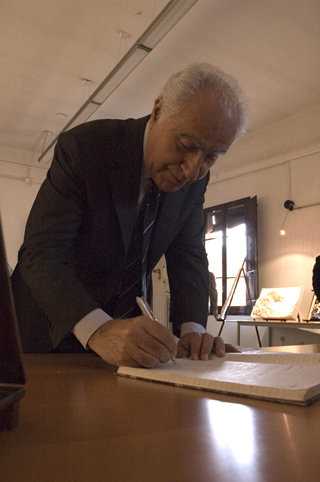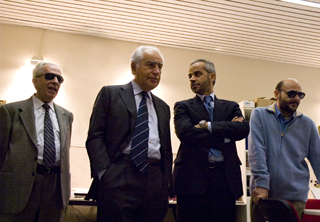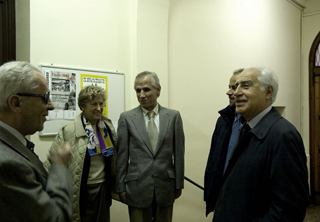The Prefect of Bologna Visits Cavazza
by Ernesto Dini, picture by Stefano Mazzali
In the wake of a tradition of famous personalities.
On numerous occasions, many
people have recalled how the Istituto Cavazza, which will soon celebrate 125
years of history, holds a very important place in the heart of the people of
Bologna and in the cultural, civil and social tissue of the City.
The
Cavazza has always represented a reference point of great importance in regards
to integration, training, rehabilitation and independence of blind and visually
impaired persons. In the last decades, it has become a centre of excellence at
the European level for the development and dissemination of new and special
technologies allowing visually impaired people to use the computer, multimedia
products, mobile phones and advanced computer science systems for knowledge,
information communication.
The Prefect of Bologna is well aware of the
initiatives supported by Cavazza and the results attained. He was accompagnied
on last October 19 by the Chief of Cabinet Matteo Piantedosi and visited the
Istituto with interest.
Welcomed by the Istituto's President Pier Michele Borra, Counsellor Ernesto
Dini, Director Mario Barbuto and by a large group of collaborators, the
Prefect began his visit by pausing with students registered in the course to
become telephone operators, discussed teaching methodology and programs with the
students and encouraged them to get involved in their studies to ensure future
employment.
The Prefect demonstrated a particular interest during his visit
to the Technology Help Centre Augusto Romagnoli, a
modern centre headed by specialized experts with the duty to
illustrate and experiment with the most advanced educational aids and adaptive
communication and information technology present on the European and
international markets. There were a wide variety of tools used in the field
of education bye the youngest groups in kindergarden to students integrated
in regular high schools such as Braille lines, voice synthesis for the computer,
Braille embossers, audiobooks for immediate reading of print material, various
tools for people with low vision (colour portable or table CCTVs, large screen
software).
The Technology Help Centre counted 342 visitors in year 2004,
formed by 80% of persons with low vision and 10% were family members, teachers
and school employees, while the very high number of telephone calls concerned
mostly blind people calling from every part of Italy.
The last
stopping place was the Anteros Museum, where are preserved, placed on tables,
reproductions of major works of art in relief, modern and contemporary paintings
as well as from the Renaissance: Mona Lisa, the Birth of Venus, Magdalen Crying
to Saint George and the Dragon, to name a few. The professionals at the
Museum, renown in the City of Bologna, explained the techniques used to
tridimensionally reproduce these works of art, and the importance of the
initiative. It aims to create and develop
visually impaired people's interest in pictorial art through tactile exploration
of well-known paintings, a new educational method followed with interest and the
numerous expectations regarding its pedagogical value.
develop
visually impaired people's interest in pictorial art through tactile exploration
of well-known paintings, a new educational method followed with interest and the
numerous expectations regarding its pedagogical value.
The visit ended in the
room of the Board of Directors with a brief and cordial conversation at the end
of which the Prefect has expressed to the management and collaborators words of
appreciation and satisfaction for the work done at the Istituto, ensuring
solidarity and availability to overcome and resolve issues needing to be
addressed.
The visit by the Prefect of Bologna is part of a long tradition of
famous and prestigious visitors to the Istituto Cavazza: the Queen Margherita of
Savoy in the 900s, and more recently, the archbishops of Bologna Giacomo Lercaro
and Antonio Poma, the then President of the Republic Francesco Cossiga, Helen
Keller and Gina Lollobrigida as well as ministers, members of parliament,
institutional authorities and representatives of the City of Bologna. The
Istituto has earned general affection and consideration during the course of its
125 years of life.